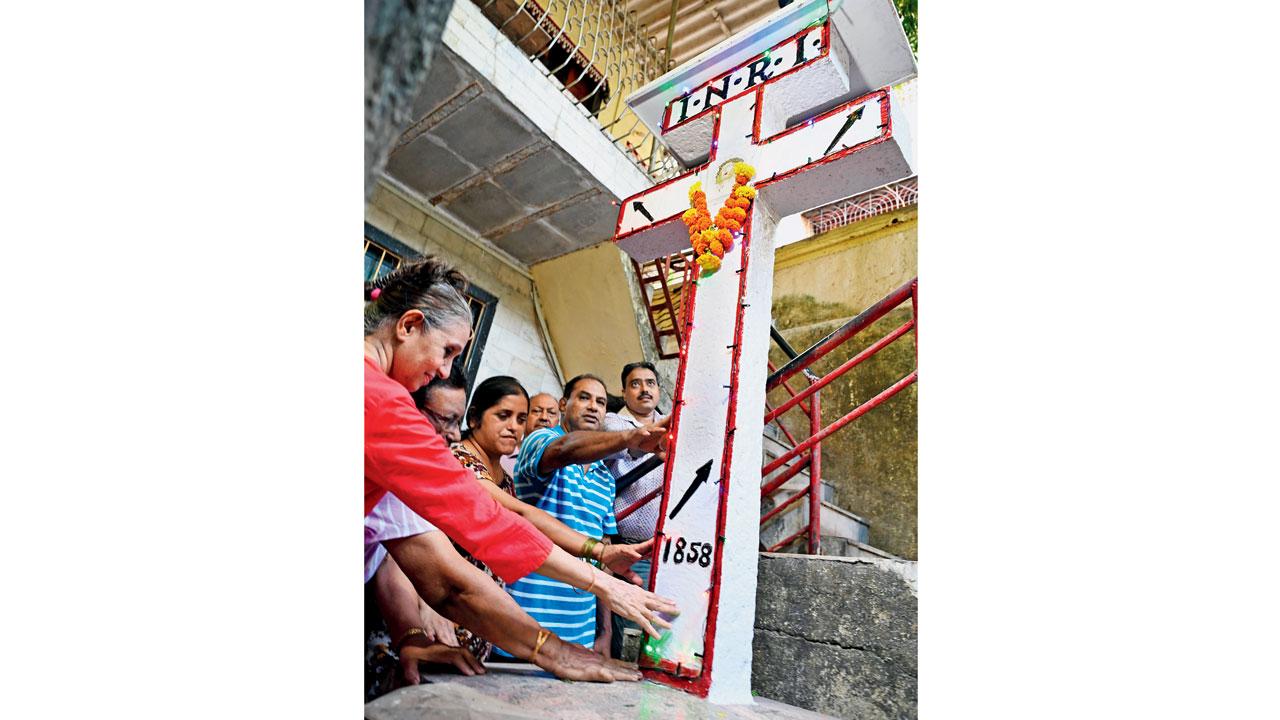The month-long celebration of the Cross holds more community significance than a religious one. And the decline in participation represents a loss of the city’s social fabric

Last year’s celebration of the feast at Our Lady of Salvation Church Grounds, Dadar
At Prabhadevi, between D’silva Wadi and D’Abreo Wadi, stands a cross where residents would gather every evening in May, the Month of the Cross and say the Rosary prayers. Once it was over, a family from the wadi would distribute wafers and boiled chana, an economical choice when serving a large number of people. If someone were feeling rich, a box of Frooti or patties would be added to the paper plates.
ADVERTISEMENT
“On the day of the Feast,” laughs chef Michael Swamy, recalling the fondest memories of growing up in the area, “usually towards the end of the month, we kids would decorate the Cross with candles and garlands made of real flowers. Dinner would be chicken, sorpotel, pulao, and cheap alcohol, ending compulsorily with a yelling match. A huge fight would invariably break out between the D’silvas and D’abreos, who were friendly to each other all month long—we’d wait for it. “No one has the time to come for the rosary. Like people and Frooti, the garlands are fake, too. Neighbours who have known each other so well for over 50 years don’t even pretend they care anymore. We are only social on social media.”

Residents of Marol Village observe the daily rosary prayers in May. The Day of the Cross is celebrated on May 3. Pic/Atul Kamble
Holy Cross Day, or the Day of the Cross. is celebrated on May 3 every year. Marol’s Parish Counsellor Sachin Periera explains it’s significance: “It recalls the crucifixion of Jesus Christ and the redeeming benefits of his Passion and death. In our Gaothan of St John the Evangelist Church Marol parish, we have special prayers on that day following a month of community rosary at the various crosses in the village.”
On average, 40 to 50 people attend it every day at 8 pm, and special prayers are offered for peace around the world and in India. Each family brings some snacks to distribute after the rosary. “At the end of the month,” he continues, “We have a fellowship get-together, where we have food, dance, and music.” Periera feels that in these fast and busy times, at least at rosary, families get to spend some time with their neighbours.
Kurla’s distinctive Portuguese-style façaded Holy Cross Church celebrated its 444th year with a community kitchen, brass band, and a parade of floats headed to the church for a soiree of singing, music, and traditional food. In 1548, St. Francis Xavier, Apostle to the Indies, petitioned the King of Portugal for a land grant in Kurla to build a church. The Jesuits came into Bandra and Kurla in 1573, and the Holy Cross Church was built in 1580. The heritage cross stood on a hillock, half a kilometre from Holy Cross Church, and was called the Phool Dongri Cross. Once the hillock was razed, the Phool Dongri Cross and its annual feast celebration were shifted to the church compound.
“Originally, the Feast of the Exaltation of the Holy Cross was celebrated in September,” Fr Milton Gonsalves tells mid-day, “In India, the Feast of the Finding of the Holy Cross (also known as the Invention of the Cross) is celebrated on May 3, when the Cross was found by St. Helena.” It is said that St. Helena, the mother of Roman Emperor Constantine recovered the True Cross at the Holy Sepulchre in Jerusalem when she travelled to the Holy Land.
These feasts commemorate different events related to the Cross, its discovery and its significance in Christian theology. Special masses or services are dedicated to the feast day, with prayers, hymns, and readings from the Bible; some churches also organise processions. While specific customs and traditions can vary depending on the parish, a festive atmosphere often prevails, with food, music, and fellowship.
Ville Parle’s 73-year-old resident, Glen Lawrence of St Francis Xavier’s parish, reminisces when everyone would come home from work and attend the rosary. “Now no one has a fixed schedule; everyone is out of sync, and that makes it difficult for people to attend the rosary,” he says, adding “COVID-19 ruined it further. People stopped coming, and things never picked up afterwards. In our compound, parishioners would get together and have cakes, cold drinks, and boiled chana. It brought forth a sense of community that seemed to be slipping away. It’s a family affair now. While the big feast is on May 31, we continue the rosary till June 7, when we commemorate my parent’s death anniversary.”
 Subscribe today by clicking the link and stay updated with the latest news!" Click here!
Subscribe today by clicking the link and stay updated with the latest news!" Click here!







